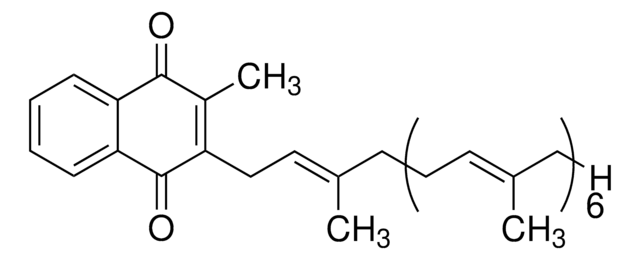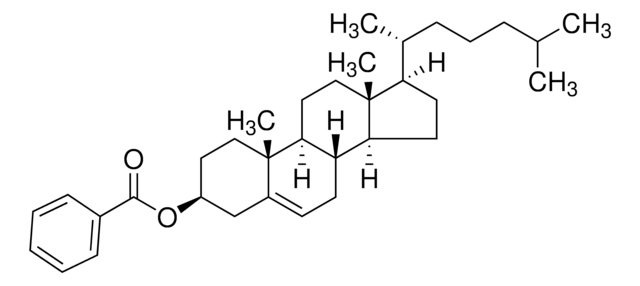1538006
USP
Phytonadion
United States Pharmacopeia (USP) Reference Standard
Synonym(e):
81818-54-4
Anmeldenzur Ansicht organisationsspezifischer und vertraglich vereinbarter Preise
Alle Fotos(1)
About This Item
Empfohlene Produkte
Qualität
pharmaceutical primary standard
API-Familie
phytonadione
Hersteller/Markenname
USP
Anwendung(en)
pharmaceutical (small molecule)
Format
neat
Lagertemp.
2-8°C
Allgemeine Beschreibung
This product is provided as delivered and specified by the issuing Pharmacopoeia. All information provided in support of this product, including SDS and any product information leaflets have been developed and issued under the Authority of the issuing Pharmacopoeia.For further information and support please go to the website of the issuing Pharmacopoeia.
Anwendung
Phytonadione USP reference standard, intended for use in specified quality tests and assays as specified in the USP compendia. Also, for use with USP monographs such as:
- Phytonadione Tablets
- Phytonadione Injectable Emulsion
- Oil-Soluble Vitamins Preparation
- Oil-Soluble Vitamins Tablets
- Menaquinone-4
- Oil-Soluble Vitamins Oral Solution
Phytonadione USP reference standard, intended for use in specified quality tests and assays as specified in the USP compendia. Also, for use with USP monographs such as:
- Phytonadione Tablets
- Phytonadione Injectable Emulsion
- Phytonadione Compounded Oral Suspension
- Oil-Soluble Vitamins Preparation
- Oil-Soluble Vitamins Tablets
- Menaquinone-4
Hinweis zur Analyse
These products are for test and assay use only. They are not meant for administration to humans or animals and cannot be used to diagnose, treat, or cure diseases of any kind.
Sonstige Hinweise
Sales restrictions may apply.
Ähnliches Produkt
Produkt-Nr.
Beschreibung
Preisangaben
H-Sätze
P-Sätze
Gefahreneinstufungen
Aquatic Chronic 4
Lagerklassenschlüssel
10 - Combustible liquids
WGK
WGK 1
Flammpunkt (°F)
Not applicable
Flammpunkt (°C)
Not applicable
Analysenzertifikate (COA)
Suchen Sie nach Analysenzertifikate (COA), indem Sie die Lot-/Chargennummer des Produkts eingeben. Lot- und Chargennummern sind auf dem Produktetikett hinter den Wörtern ‘Lot’ oder ‘Batch’ (Lot oder Charge) zu finden.
Besitzen Sie dieses Produkt bereits?
In der Dokumentenbibliothek finden Sie die Dokumentation zu den Produkten, die Sie kürzlich erworben haben.
Kunden haben sich ebenfalls angesehen
Carmela T M Mascio et al.
Antimicrobial agents and chemotherapy, 58(7), 3976-3982 (2014-05-07)
Surotomycin (CB-183,315) is an orally administered, minimally absorbed, selective bactericidal cyclic lipopeptide in phase 3 development for the treatment of Clostridium difficile-associated diarrhea. The aim of this study was to evaluate the emergence of resistance in C. difficile (ATCC 700057
C Rodriguez et al.
Food microbiology, 42, 166-171 (2014-06-16)
Clostridium difficile has been isolated from food animals and meat, specially ground pork and ground beef. The recovered isolates were closely related to C. difficile human strains, indicating that animals and food are possible transmission routes of human C. difficile infection. The
Ji-Hoi Moon et al.
BMC microbiology, 14, 218-218 (2014-08-26)
Polyphosphate (polyP) has bactericidal activity against a gram-negative periodontopathogen Porphyromonas gingivalis, a black-pigmented gram-negative anaerobic rod. However, current knowledge about the mode of action of polyP against P. gingivalis is incomplete. To elucidate the mechanisms of antibacterial action of polyP
C Rodriguez et al.
Veterinary microbiology, 172(1-2), 309-317 (2014-06-05)
Clostridium difficile has been identified as a significant agent of diarrhoea and enterocolitis in both foals and adult horses. Hospitalization, antibiotic therapy or changes in diet may contribute to the development of C. difficile infection. Horses admitted to a care
Hrisi Bahar Tokman et al.
Clinical laboratory, 60(11), 1879-1886 (2015-02-05)
Anaerobic bacteria play an important role in eye infections; however, there is limited epidemiologic data based on the the role of these bacteria in the etiology of keratitis and endophthalmitis. The aim of this re- search is to determine the
Unser Team von Wissenschaftlern verfügt über Erfahrung in allen Forschungsbereichen einschließlich Life Science, Materialwissenschaften, chemischer Synthese, Chromatographie, Analytik und vielen mehr..
Setzen Sie sich mit dem technischen Dienst in Verbindung.








